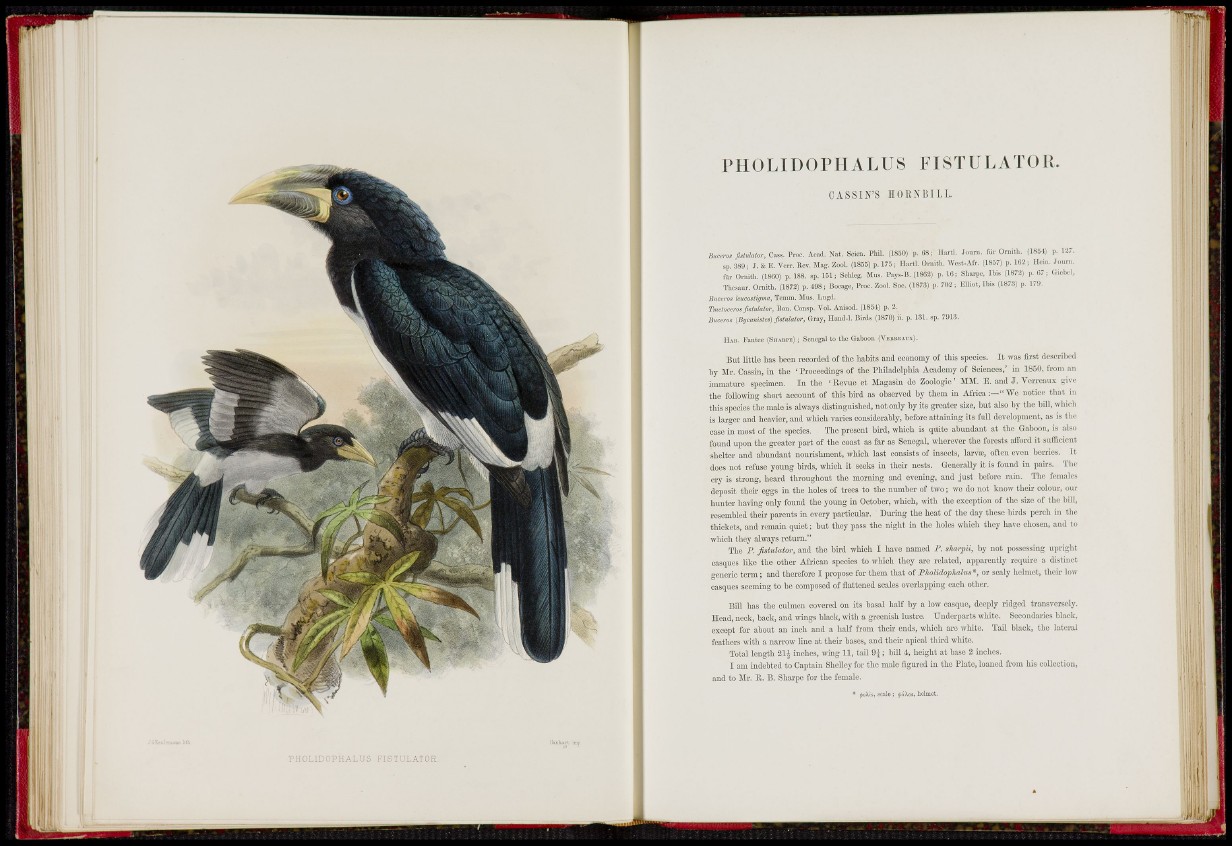
i .
I jl
PHULlDOPHALUü FISTULATOR
PIIOLIDOPHALUS FISTULATOR.
C A S S I N ' S HOllNBILL.
Bachras fistulator, Cass. Proc. Aca<l, Nat. Seien. Pliil. (1850) p. 68; lla.tl. Jouni. für OruitU. (185-1.) p. lar.
sp 389 • J . & E . Verr. Rev. Mag. ZooL (1855) p. 175 ; Hartl. Omith. Wcst-Afr. (1H57) p. 102 ; I lea. Joun..
tUr Ornith. (1860) p. 188. sp. 151; Schleg. Mus. Pays-B. (1862) p. l(i; Sharpe, Ibis (1872) ,). 07; Ciicbtl.
Thcsaur, Ornitli. (1872) p. 498; Bocage, Proc. Zool. Soc. (1873) p. 70^; Ulliot, Ibis (1873) p. 179.
Bucuros leucostigma, Tomm, Mus. L\igil.
Tmctoce,-OS fistulator, Bou. Coiisp. Vol. Anisod. (185-1.) p. 2.
Suceros {Bycanisies) fistulator, Gray, Ha>id-1, Birds (1870) ii. p. ISL. sp. 7913.
HAH. Fantee (SH.VÄPE) ; Seiii3gal to the Gaboon (VEKREAUX) .
But little has been recorded of the habits aud economy of this species. It was first described
by Mr. Cassin, in tlie ' i'roceediugs of the Philadelphia Academy of Sciences,' in 1Ö50, from an
immature specimen. In the ' Revue et llagasin de Zoologie ' UM. E. and J. Verrcau.M siive,
the following short account of this bird as observed by them in Africa;—"We notice that m
tliis species the nrnle is always distinguished, not only by its greater size, but also by the bill, whi<-li
is larger and heavier, and which varies considerably, before attaining its full development, as is the
case in most of the species. The present bird, which is qüitc abundant at tlie Gaboon, is also
found upon the greater part of the coast as far as Senegal, wherever the forests afford it sufliciont
shelter and abundant nourishment, which last consists of insects, larv®, often even berries, it
does not refuse young bh-ds, which it seeks in their nests. Generally it is found in pairs. The
cry is strong, heard throughout the morning and evening, and just before rain. The females
deposit their eggs in the holes of trees to the number of two; we do not know their colour, our
hunter having only found the young in October, which, with the exception of the size of the bill,
resembled their parents in every pai-ticulai-. During the heat of the day these birds perch in the
thickets, and remain quiet; but they pass the night in the holes which they have chosen, and to
which they always return."
The P. fistulator, and the bird which I have named P. sharpii, by not possessing upright
casques like the other African species to which they are related, apparently require a distinct
generic term; and therefore I propose for them that of Fholidophalus*, or scaly helmet, their low
casques seeming to be composed of flattened scales overlapping each other.
Bill lias the culmen covered on its basal half by a low casque, deeply ridged transversely.
Head, neck, back, and wings black, with a greenish lustre. Underparts white. Secondaries black,
except for about an inch and a half from their ends, which are white. Tail black, the lateral
feathers with a narrow line at their bases, and their apical third white.
Total length inchcs, wmg 11, taü 9 | ; bUl 4., height at base 2 inches.
I am indebted to Captain Shelley for the male figured in the Plato, loaned from his collection,
and to Älr. 11. 13. Sharpe for the female.
* foXis, scale ; fitXos, helmet